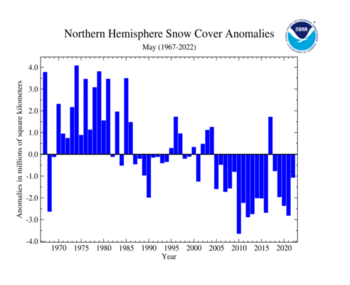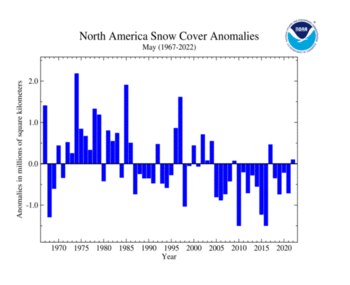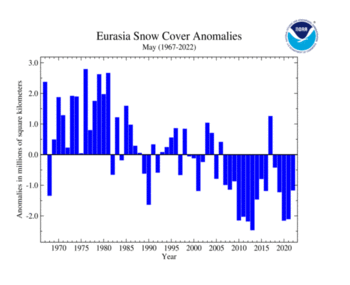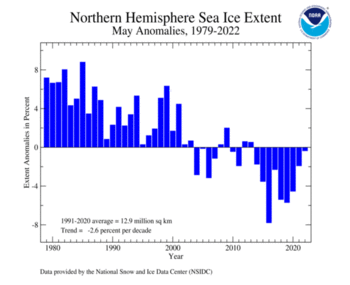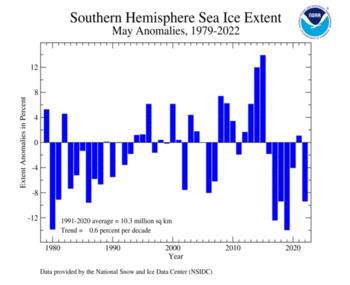Northern Hemisphere Snow Cover Extent
| May 2022 | Snow Cover Extent | Anomaly 1991-2020 | Trend per decade | Rank (56 years) | Record | ||||||
|---|---|---|---|---|---|---|---|---|---|---|---|
| million km² | million mi² | million km² | million mi² | million km² | million mi² | Year(s) | million km² | million mi² | |||
| Northern Hemisphere | 17.96 | 6.93 | -0.26 | -0.10 | -0.78 | -0.30 | Largest | 40th | 1974 | 23.09 | 8.92 |
| Smallest | 17th | 2010 | 15.38 | 5.94 | |||||||
| North America | 9.39 | 3.63 | +0.35 | +0.14 | -0.22 | -0.08 | Largest | 23rd | 1974 | 11.48 | 4.43 |
| Smallest | 34th | 2010,2016 | 7.80 | 3.01 | |||||||
| Eurasia | 8.56 | 3.31 | -0.62 | -0.24 | -0.56 | -0.22 | Largest | 44th | 1976 | 12.51 | 4.83 |
| Smallest | 13th | 2013 | 7.26 | 2.80 | |||||||
Data Source: Global Snow Laboratory, Rutgers University. Period of record: 1967–2022 (56 years)
Northern Hemisphere snow cover extent for May 2022 was 17.96 million square km (6.93 million square miles) or 1.06 million square km (410,000 square miles) below average. May was characterized by cooler-than-average conditions across parts of northwestern North America, which had above-average snow cover extent. Most of Eurasia experienced above-average temperatures and had below-average snow cover extent for May.
North American snow cover extent was above average at 9.39 million square km (3.63 million square miles). May temperatures throughout the northern Rockies, northwestern U.S. and western Canada were below average for May. Snow-covered area was at a near-average extent for the first half of May, but storms beginning in mid-May contributed to an overall snow cover extent that ranked above average for the month. Above-average extent was observed across much of the western coast of Canada and into eastern Alaska. Parts of central southern Canada, northeastern Quebec, and Labrador also experienced above-average extent. Alaska and the contiguous U.S. had a near-average extent, while Canada had a slightly above-average snow cover extent for May.
Eurasia had a below-average May snow cover extent of 8.56 million square km (3.31 million square miles), or 1.16 million square km (450,000 square miles) below the May average. Across the region, snow cover was below-average throughout central Russia, western Mongolia, and Kyrgyzstan. Meanwhile, above-average snow cover extent was observed in eastern Russia, northern Sweden, and central Finland.
Sea Ice Extent
The sea ice extent data for the Arctic and Antarctic are provided by the National Snow and Ice Data Center (NSIDC) and are measured from passive microwave instruments onboard NOAA Satellites. The sea ice extent period of record is from 1979–2022 for a total of 44 years.
| May 2022 | Sea Ice Extent | Anomaly 1991-2020 | Trend per decade | Rank (44 years) | Record | ||||
|---|---|---|---|---|---|---|---|---|---|
| million km² | million mi² | Year(s) | million km² | million mi² | |||||
| Northern Hemisphere | 12.88 | 4.97 | -0.39% | -2.55% | Largest | 31st | 1985 | 14.07 | 5.43 |
| Smallest | 14th | 2016 | 11.92 | 4.60 | |||||
| Southern Hemisphere | 9.42 | 3.64 | -8.45% | +0.68% | Largest | 38th | 2015 | 11.72 | 4.53 |
| Smallest | 7th | 2019 | 8.85 | 3.42 | |||||
| Globe | 22.30 | 8.61 | -3.96% | -1.12% | Largest | 38th | 1982 | 24.73 | 9.55 |
| Smallest | 7th | 2019 | 21.04 | 8.12 | |||||
Data Source: National Snow and Ice Data Center (NSIDC). Period of record: 1979–2022 (44 years)
Arctic sea ice extent for May 2022 was 12.88 million square km (4.97 million square miles), which is 410,000 square km (158,000 square miles) — about the size of California — below average. Overall, this was the 14th-smallest April extent since records began in 1979. Despite the below-average May Arctic sea ice extent, it was the largest May extent since 2013. Sea ice decline this month occurred mostly within Baffin Bay, the Davis Strait, and in the Barents and Bering seas.
Antarctic sea ice extent for May 2022 was 9.32 million square km (3.60 million square miles), which is 840,000 square km (322,797 square miles) below average, tying with 2018 as the fifth-smallest May extent in the 44-year record. Only the Mays of 1980, 1986, 2017, and 2019 had smaller sea ice extents. According to the NSIDC, sea ice was especially low in the Amundsen and Weddell seas.
 NOAA's National Centers for Environmental Information
NOAA's National Centers for Environmental Information
